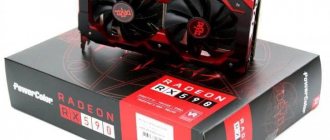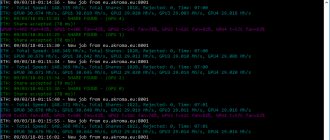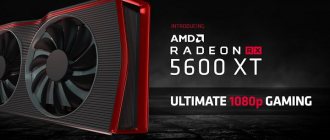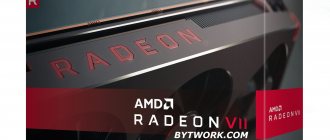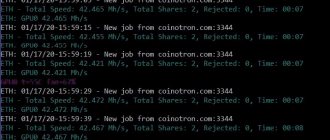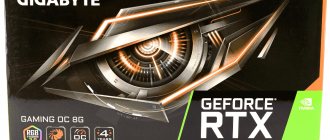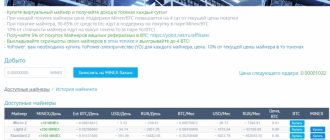In this review we will look at the ASUS RX 570 STRIX Gaming video card from AMD.
The card is equipped with a 1x8 Pin power connector and consumes from 150 Watt to 180 Watt depending on the miner, overclocking and algorithm.
With optimal overclocking via MSI Afterburner, the video card produces: 29.6 kh/s on Ethash, 855 kh/s on CryptoNightV7 and 745 kh/s on NeoScrypt.
Specifications
| Characteristics | MSI GeForce RTX 2080 Ti DUKE |
| Video memory | GDDR5 4GB |
| CPU frequency | Boost frequency: 1310 MHz |
| Energy consumption | 150 Watt, with full overclocking 180 Watt |
| Power connectors | 1x-8Pin |
| Length | 24 cm |
| Noise | 35 dB |
How much can you earn
ASUS RX 570 STRIX Gaming OC mines Ethash and CryptoNightV7 algorithms best.
Next come the algorithms that bring slightly less profit per day, but they can also be considered for mining on this map. This is NeoScrypt, X16R, X16S
And finally, algorithms, the mining of which is generally unprofitable (by mining them, you will not make a profit, but will go into the red) or, at best, you will be able to pay for the consumed electricity. These are Equihash, CryptoNight and many others.
Note that there are coins even among profitable algorithms, the mining of which is unprofitable.
We will also add that if you want to receive coins of unprofitable algorithms, you can resort to the “pseudo mining” technique. In this case, you must mine any coin of a profitable algorithm and sell it on the exchange in exchange for a coin of an unfavorable algorithm.
In order not to be unfounded, we will give specific examples. All tests were performed on 10/08/2018, that is, the difficulties and prices for the given coins are current as of 10/08/2018.
Let's start with the most profitable algorithms, for example, Ethash, an Ethereum coin. Per day from 1 video card:
- Total coins – 0.0021 ETH.
- Amount in dollars equivalent to mined coins – $0.49
Quite a good indicator for 1 video card in this series.
Below is an example of mining the Ethash algorithm on an ASUS RX 570 STRIX Gaming OC video card:
Let’s immediately look at another profitable algorithm for comparison, for example, CryptoNightV7, Monero coin. Per day from 1 video card:
- Total coins – 0.0039 XMR.
- Amount in dollars equivalent to mined coins – $0.44
Below is an example of mining the CryptoNightV7 algorithm on an ASUS RX 570 STRIX Gaming OC video card:
As you can see, the profit per day is almost the same. From time to time it happens that 1 coin of one profitable algorithm becomes much more profitable than another coin of the same algorithm, but this is literally for a day (maximum a couple of days). This is due to the increase in the rate of this coin or the factor that miners have temporarily left this coin, which means you can get more coins if you mine it.
Therefore, in fact, which algorithm is profitable to mine is up to you to decide!
Next, we will consider less profitable algorithms, for example, X16R, Ravencoin coin. Per day from 1 video card:
- Total coins – 15 RVN.
- Amount in dollars equivalent to mined coins – $0.24
The profit per day is already noticeably less than that of profitable algorithms. However, it is usually a little larger. At the time of writing, Ravencoin has dropped slightly in price.
Other less profitable algorithms work on the same principle as the profitable ones. Today 1 coin of one algorithm may be profitable, and tomorrow it will be another. The factors influencing this are the same (rate and temporary departure of miners).
Well, in the end there are unprofitable algorithms, the mining of which is either, at best, a socket, or a minus.
As for unprofitable algorithms, as we said earlier, you can resort to the “pseudo mining” technique. In this case, you will be able to receive coins of an unfavorable algorithm.
This technique can also be applied to less profitable algorithms. You must start mining any coin of a profitable algorithm and sell it during the day in exchange for the coin you need from a less profitable algorithm.
You need to sell during the day for a reason: the profitable coin you are mining may fall in price, in which case you will receive the same number of coins as you would have received if you had mined a coin of a less profitable algorithm directly, or in the worst case, even less coins
When buying Asus strix rx 570 4gb bios mod - you should know these tips
If you have decided to buy Asus strix rx 570 4gb bios mod, please take a moment to consider the following points that our testing experts have compiled into a checklist for you. By taking into account the checklist and our recommendations, you will not only save effort on your own search, but also money.
Manufacturer:
Are there any reputable manufacturers of Asus strix rx 570 4gb bios mod? Good brands usually mean good products.
Test report:
Are there any serious reviews for Asus strix rx 570 4gb bios mod? Good reviews not only praise the product to the skies, but also describe possible shortcomings.
Size:
What sizes is the product available in and is it suitable for me or my intended use?
Test results:
Which manufacturer is the winner of the Asus strix rx 570 4gb bios mod test? Do I already know other products from this manufacturer and am I satisfied with them?
Price:
Where is the best value for money?
Comparison:
Comparing prices is always useful! You don't want to spend an unreasonable amount of money on a product if the same thing is cheaper elsewhere.
To choose the best product for you, you should use the Asus strix rx 570 4gb bios mod product comparison and rating list. If you really want to do your own comparison test, our experts recommend ordering multiple products at once. Only through direct comparison can you determine the winner of your individual test.
Mining performance
In mining, the video card produces the following hashrate indicators:
Hashrate
| Algorithm | MH/s (stock/overclock) |
| Ethash | 24/29 (MH/s) |
| NeoScrypt | 650/740 (Kh/s) |
| CryptoNightV7 | 790/845(H/s) |
| PHI1612 | 8/11Mh/s |
| Lyra2z | 0.34/0.43Mh/s |
| X16r | 4.3/5.1Mh/s |
| TimeTravel10 | 7.4/8.1Mh/s |
| Lyra2REv2 | 28900/29600(Kh/s) |
| PHI2 | 2.2/2.7Mh/s |
Memory and overclocking
The video card is equipped with 4 gigabytes of GDDR5 graphics memory. Most often, cards come with memory from Hynix, and a little less often Elpida.
Below is a screenshot of the ASUS RX 570 STRIX Gaming OC video card from the GPU-z program.
Overclocking for the Ethash algorithm (for example, Ether coins).
By core:
Core clock ~ 1100 (-300) – for ideal operation without crash.
By memory:
Memory clock ~ 2000 is an ideal overclocking indicator, at which the card works stably (does not produce rejects) and the system does not reboot (does not crash)
Note that you can overclock the video card even more. The settings we have given are presented as an example of stable operation without crashes and frequency resets.
With this overclock the card produces:
Ethash ~ 29.6 Mh/s
For the CryptoNightV7 algorithm.
By core:
Core clock ~ 1300 – for ideal operation without crash.
By memory:
Memory clock ~ 2200 is an ideal overclocking indicator, at which the card works stably (does not produce rejects) and the system does not reboot (does not crash)
CryptoNightV7 ~ 820 h/s
In case you overclock the card even more, we advise you to monitor the farm during the day (and add +10 on the overclocking scale) - since the frequencies may drop due to overclocking.
Timings
Below are the timings for the ASUS RX 570 STRIX Gaming OC 4GB video card.
Select the memory of your video card.
Hynix
999000000000000022559D0010DE5B4480551312B74C450A00400600750414206A8900A00200312010112D34A42A3816
External sources of information for Asus strix rx 570 4gb bios mod
On the following sites you will find more detailed information and reviews about Asus strix rx 570 4gb bios mod. Think about what you expect from the product and make sure you get the information you need before purchasing to ensure you're satisfied later.
Price comparison @ Yandex.Market
Information @ wikipedia.org
To find the best product, it makes sense to study test reports because test winners are determined from a variety of similar products and should be to your liking.
Equally suitable are websites where other Asus strix rx 570 4gb bios mod buyers can post reviews of their experiences according to their own hands-on tests to form their opinions. You can rely on reviews and recommendations from customers, especially if they have been using the products for a long time. Filter the information needed to get the picture and weed out irrelevant comments.
Energy consumption and downvolting
The video card is equipped with a 1x8 Pin power connector and consumes from 150 Watt to 180 Watt depending on overclocking, miner and algorithm, where 75 Watt goes through the riser (or PCI-e in the motherboard), and the remaining 75 Watt or 105 Watt goes through PCI-e wires from the power supply.
With optimal overclocking via MSI Afterburner using the Ethash algorithm, the card consumes ~150 Watts.
For a farm of 6 ASUS RX 570 STRIX Gaming video cards and the connected system (motherboard, processor and hard drive), 1 1100 Watt power supply or 2 700-750 Watt power supplies are suitable.
You can find out how to power the farm with 2 power supplies on our website.
Also on our website you can choose an excellent block for mining: in the corresponding section there are detailed articles about different power supplies: their configuration, efficiency, drawdowns, ripple, analysis and much more.
When using downvolting, card consumption can be reduced by 20 -30 Watts with almost no loss in hashrate on many algorithms. The card will produce around 27.1 Mh/s on Ethash.
This way you will power a rig of 6 video cards equal in power consumption to about 5 video cards with almost no loss in profit and with savings on an outlet or the ability to connect more video cards if you hit a power ceiling.
Specifications
- AMD Radeon RX 570 GPU
- OpenGL: OpenGL®4.5
- Video memory: GDDR5 4GB
- Processor frequency: 1310 MHz (OC Mode), 1300 MHz (Gaming Mode)
- Stream Processors: 2048
- Memory frequency: 7000 MHz
- Memory interface: 256-bit
- Resolution: 5120×2880
- Power connectors: 1 x 8-pin
- Accessories: 2 x ROG Cable Ties, 2 x Orange Color Decals
- Software: ASUS GPU Tweak II & Driver Aura (Grphaics Card) Utility
- Dimensions: 9.5 x 5.1 x 1.5 inches / 24 x 12.9 x3.9 cm
Interfaces
- DVI Output x 2 (Native) (DVI-D)
- HDMI Output x 1 (Native) (HDMI 2.0)
- Display Port x 1 (Native) (Regular DP)
- HDCP support: Yes
To ensure the best cooling performance, ASUS STRIX-RX570-O4G-GAMING extends the heatsink by 2 slots. Before purchasing, check the dimensions of the chassis and motherboard to make sure they will fit into your system!
What coins can you mine?
As mentioned earlier, the best mined coins are the Ethash and CryptoNightV7 algorithms. Also sometimes the Lyra2REv2 and CryptoNightHeavy algorithms work well.
Next are the algorithms that bring slightly less profit per day, but they can still be considered for mining: NeoScrypt, X16R, X16S.
Mined coins
| Algorithms | Coins |
| Ethash | Ethereum, Ethereum Classic, Ellaism, Metaverse, Expanse, Krypton, Ubiq, Soilcoin, Shift, Pirl, Musicoin, Akroma, Callisto, DubaiCoin, Nilu, MIX, Goldiam, MOAC, Ether1, EtherSocial, WhaleCoin |
| NeoScrypt | Crowdcoin, Dinero, Feathercoin, GoByte, Halcyon, Innova, Vivo, Trezarcoin, Orbitcoin, Phoenixcoin, 01 Coin, Agena, Airin, Akencash, Banq, Cerberus, CharmCoin, Coin2Fly, CoreZ, Desire, GoaCoin, HashRental, IQ Cash, Ignition, Kicker Romm, LuckyBit, Masterbit, Momo Cash, NyxCoin, Onex Cash, Qbic, Qyno, Rapture, Sigil, SimpleBank, Sparks, SunCoin, SuperLumic, Uniform Fiscal Object, ZCore, Zixx |
| CryptoNightV7 | Monero, BBSCoin, Citadel, DigitalNote, Elya, Graft, IntenseCoin, Parsicoin, NXB, MoneroV, Lethean, Kepl, Quantum RL, Superior Coin, Wownero |
| TimeTravel10 | Bitcore |
| Lyra2REv2 | Monacoin, Galactrum, Rupee, Straks, Vertcoin, Verge, Absolute, Exvo, HanaCoin, Kreds, MTI Coin, WeyCoin |
| X16R | Ravencoin, Motion, GPUnion, Gravium, Help The Homeless, Hilux, MoonDEX, XChange, Stone Coin, Sovereign, Proton Coin, OPL Coin, xGalaxy |
| X16S | Pigeoncoin, Rabbit, Reden, RESQ Chain |
| Lyra2z | Actinium, Alpenschilling, Criptoreal, GINcoin, Infinex, MCT+, Taler, Respawn, STIM COIN, Taler, Vertical, Zcoin |
| CryptoNightHeavy | Alloy, Loki, Qwerty coin, RyoCurrency, zBucks |
you can use these algorithms on our website.
You can also .
Asus strix rx 570 4gb bios mod thematic video
ASUS ROG Strix RX 570 Bios Modding- GPU Mining – Links in description
PolarisBiosEditor: https://github.com/jaschaknack/PolarisBiosEditor/tree/110aa3a5a0aeafe16bb0a96b53583e7e8e77999b AtiFlash …
So that you can get an idea of the product in advance, we recommend searching YouTube for a test or rating for Asus strix rx 570 4gb bios mod. These comparison videos are a good addition to the review. On YouTube you can see the product in action and evaluate in advance whether it is right for you.
Comparison with analog video card line
Video cards of the RX570 4 GB series differ greatly from each other in such factors as the cooling system, build quality, and price.
Let's start with the first point - temperatures. Asus RX 570 Strix does not have a very good cooling system. The card gets quite hot and without additional cooling it simply overheats and drops frequencies.
For example, the same Powercolor has a much better cooling system. In part, the card can be compared with the stump of the Sapphire RX 570 Pulse ITX, but of course Asus will cool the video card better, but not much.
As for the build quality, it is rather average. The plastic on the casing is very weak. Coolers break easily and have a high percentage of defects.
In fact, the build quality is slightly ahead of MSI Armor. But it is much inferior to the same Powercolor.
The price for this card is average: not the most expensive, but not the cheapest either. For the same money you can buy a card with a better cooling system and build.
Comparison of RX570 with RX580
The difference between these video cards is not very big. For example, in mining on Ethereum, one 580 produces:
- Total coins – 0.0023 ETH.
- Amount in dollars equivalent to mined coins – $0.49
One RX570 video card produces:
- Total coins – 0.0021 ETH.
- Amount in dollars equivalent to mined coins – $0.49
In fact, these video cards are not very different, 580 brings a little more, and then on some algorithms the increase in mining is 0%. And the price difference between these video cards is several thousand rubles.
However, if you can buy a video card with a minimal overpayment, then it is better to take the 580, since it will be a little easier to resell later.
What drivers should I use?
It is best to use the latest AMD “Adrenalin Edition” driver, which you can download from the official AMD website.
https://support.amd.com/en-us/kb-articles/Pages/Radeon-Software-Adrenalin-Edition-18.5.1-Release-Notes.aspx
Video accelerator Asus ROG Strix RX 570 OC (4 GB): a solid mid-level solution with a quiet cooler
Content
- Features of the device(s)
- Test bench configuration, list of testing tools
- Test results
- conclusions
Reference materials
- Gaming Graphics Card Buyer's Guide
- AMD Radeon HD 7xxx/Rx Reference
- Guide to Nvidia GeForce GTX 6xx/7xx/9xx
- Capabilities for processing Full HD video streams
- Methodology for testing in 3D games and settings
Object of study
: Commercially available 3D graphics accelerator (GPU) Asus ROG Strix RX 570 OC 4GB 256-bit GDDR5
Manufacturer information
: Asustek Computer (Asus brand) was founded in 1989 in the Republic of China (Taiwan). Headquarters in Taipei/Taiwan. On the market in Russia since 1992. The oldest manufacturer of video cards and motherboards. Now it produces a very wide range of products in many sections of the IT industry (including the mobile segment). Manufactured in China and Taiwan. The total number of employees is about 2000 people.
Device(s)
| Asus ROG Strix RX 570 OC 4 GB 256-bit GDDR5 (ROG STRIX-RX570-O4G-GAMING, P/N 90YV0AJ0-M0NM00) | |||
| Parameter | Meaning | Nominal value (reference) | |
| GPU | Radeon RX 570 (Polaris 20) | ||
| Interface | PCI Express x16 | ||
| GPU operating frequency (ROPs), MHz | OC Mode: 1200—1320 Gaming Mode: 1170—1300 | 1168—1244 | |
| Memory operating frequency (physical (effective)), MHz | 1750 (7000) | 1750 (7000) | |
| Memory bus width, bits | 256 | ||
| Number of computational units in the GPU | 32 | ||
| Number of operations (ALU) per block | 64 | ||
| Total number of ALUs | 2048 | ||
| Number of texturing units (BLF/TLF/ANIS) | 128 | ||
| Number of rasterization units (ROP) | 32 | ||
| Dimensions, mm | 240×115×38 | 220×100×35 | |
| Number of slots in the system unit occupied by a video card | 2 | 2 | |
| PCB color | black | black | |
| Energy consumption | Peak 3D, W | 147 | 150 |
| In 2D mode, W | 18 | 20 | |
| In sleep mode, W | 3 | 3 | |
| Noise level | In 2D mode, dBA | 18,0 | 18,0 |
| In 2D mode (video viewing), dBA | 18,0 | 18,0 | |
| In maximum 3D mode, dBA | 27,0 | 28,0 | |
| Output jacks | 2×DVI (Dual-Link/HDMI), 1×HDMI 2.0b, 1×DisplayPort 1.3/1.4 | 1×HDMI 2.0b, 3×DisplayPort 1.3/1.4 | |
| Multiprocessing support | CrossFire | ||
| Maximum number of receivers/monitors for simultaneous image output | 4 | 4 | |
| Additional power: number of 8-pin connectors | 1 | No | |
| Additional power: number of 6-pin connectors | No | 1 | |
| Maximum 2D resolution | Display Port | 4096×2160 | |
| HDMI | 4096×2160 | ||
| Dual-Link DVI | 2560×1600 | ||
| Single-Link DVI | 1920×1200 | ||
| Maximum 3D resolution | Display Port | 4096×2160 | |
| HDMI | 4096×2160 | ||
| Dual-Link DVI | 2560×1600 | ||
| Single-Link DVI | 1920×1200 | ||
Search prices in the iXBT.com catalog
| Equipped with local memory | |
| The card has 4 GB of GDDR5 SDRAM memory located in 8 4 Gbit chips on the front side of the PCB. Micron (Elpida) memory chips (GDDR5) are designed for a nominal operating frequency of 1750 (7000) MHz. | |
| Comparison with reference design (reference) | |
| Front view | |
| Asus ROG Strix RX 570 OC 4GB 256-bit GDDR5 | AMD Radeon RX 570 |
| Back view | |
| Asus ROG Strix RX 570 OC 4GB 256-bit GDDR5 | AMD Radeon RX 570 |
The PCB is entirely designed by Asus engineers.
At the end at the rear of the card there is a 4-pin power connector for the case fan, by switching it from the motherboard or installing it additionally, you can make it work, increasing or decreasing the speed in accordance with the heating of the GPU.
The power supply circuit has 8 phases (6+2) and is controlled by a Digi+ ASP1211 digital controller. Traditionally for Asus, the power system is made using Super Alloy Power II technology, using modern solid-state capacitors. Condition monitoring is controlled by the IT8705F/AF controller manufactured by ITE (Integrated Technology Express).
In overclocking mode (OC Mode, by default), the frequencies of this accelerator are increased by 6.1% compared to the standard parameters of the reference card, which can provide a performance increase of 5.5%-6% depending on the resolution and operating mode.
Frequency and voltage regulation can be done using the proprietary Asus GPU Tweak II utility, which comes with the card on disk, and can also be downloaded from the manufacturer’s website. The latest version of the utility allows you to automatically configure the accelerator to operate at the maximum possible frequencies (if the owner, for example, does not want to independently search for the achievable maximum).
The card has a different set of video outputs compared to the reference sample: not 3 DP + 1 HDMI, but 1 DP + 1 HDMI + 2 DVI.
| Cooling system | |
| Before us is a DirectCu II cooler. Its main part is a massive nickel plated radiator. Two heat pipes pressed into the copper base ensure even heat distribution across the radiator fins. An additional small radiator cools the power transistors. A casing with two fans operating at the same speed is installed on top of the radiator. Asus declares a special material for the fan blades, which ensures long-term operation of the impellers with constant air flow. Let me remind you that the highlight of the cooling system of the Strix series cards is that the fans stop in case of idle time when the GPU heat is low. Therefore, do not be alarmed if the fans on the accelerator do not rotate when you start your PC. Memory chips are not cooled. A rod is installed at the top end of the card, which provides rigidity to the video card (preventing bending of the printed circuit board). The CO is equipped with Aura lighting, the color of which can be controlled using the above-mentioned GPU Tweak II utility. After a 6-hour run under load, the maximum core temperature did not exceed 69 degrees, which is a good result for a video card of this level. | |
| Temperature monitoring using MSI Afterburner (author A. Nikolaychuk AKA Unwinder) |
Noise measurement technique
- The room is soundproofed and muffled, reverberations are reduced.
- The system unit in which the noise of video cards was studied does not have fans and is not a source of mechanical noise.
- The background level of 18 dBA is the noise level in the room and the noise level of the sound level meter itself.
- The measurements were taken at a distance of 50 cm from the video card at the level of the cooling system.
- Measurement modes:
- Idle mode in 2D: an Internet browser with the site iXBT.com, a Microsoft Word window, and a number of Internet communicators are loaded.
- 2D mode with movie viewing: SmoothVideo Project (SVP) is used - hardware decoding with insertion of intermediate frames.
- 3D mode with maximum load on the accelerator: the FurMark test is used.
- The assessment of noise level gradations is carried out according to the method described here: 28 dBA or less: noise is poorly distinguishable even at a distance of one meter from the source, even with a very low level of background noise. Rating: minimal noise.
- from 29 to 34 dBA: the noise is noticeable already from two meters from the source, but does not particularly attract attention. This level of noise can be tolerated even during long-term operation. Rating: low noise.
- from 35 to 39 dBA: the noise is reliably differentiated and noticeably attracts attention, especially in rooms with low noise levels. You can work with this level of noise, but it will be difficult to sleep. Rating: average noise.
- 40 dBA or more: such a constant level of noise begins to irritate, you quickly get tired of it, and you want to leave the room or turn off the device. Rating: high noise.
In 2D idle mode the temperature was 38°C and the fans were not running. The noise was equal to the background - 18.0 dBA.
When watching a movie with hardware decoding, the temperature rose to 46 °C, the fans did not turn on. The noise was also equal to the background - 18.0 dBA.
At maximum load in 3D, the temperature reached 69 °C. At the same time, the fans spun up to 2141 rpm, the noise increased to 27.0 dBA. This CO can be called quiet.
Thermal photograph
The greatest heating is on the reverse side of the PCB in the area of memory chips.
| Equipment | |
| The basic package should include a user manual, a disk with drivers and utilities. We see a basic set plus a bonus in the form of branded zip ties. | |
| Package |
Installation and drivers
Test bench configuration
- Computer based on Intel Core i7-5960X processor (Socket 2011): Intel Core i7-5960X processor (o/c 4 GHz);
- With Intel Thermal Solution RTS2011LC;
- ASRock Fatal1ty X99X Killer motherboard based on Intel X99 chipset;
- RAM 16 GB DDR4 G.Skill Ripjaws4 F4-2800C16Q-16GRK 2800 MHz;
- hard drive Seagate Barracuda 7200.14 3 TB SATA2;
- 2 SSD Corsair Neutron SSD CSSD-N120GB3-BK;
- Thermaltake Toughpower DPS G 1050W (1050 W) power supply;
- Corsair Obsidian 800D Full Tower case.
List of testing tools
The testing methodology and all settings can be viewed here.
- Fallout 4
(Bethesda Games Studios/Bethesda Softworks, DirectX 11) - Rise Of The Tomb Raider
(Nixxes Software/Square Enix, DirectX 12) - Tom Clancy's Ghost Recon Wildlands
(Ubisoft/Ubisoft, DirectX 11) - The Witcher 3: Wild Hunt
(CD Projekt RED, DirectX 11) - BattleField 1
(EA Digital Illusions CE/Electronic Arts, DirectX 12) - Tom Clancy's The Division
(Ubisoft Massive/Ubisoft, DirectX 11) - Deus Ex: Mankind Divided
(Eidos Montreal/Square Enix, DirectX 12) - Far Cry Primal
(Ubisoft/Ubisoft, DirectX 11) - Hitman (2016)
(IO Interactive/Square Enix, DirectX 12) - Ashes Of The Singularity
(Oxide Games,Stardock Entertainment/Stardock Entertainment, DirectX 12)
Test results: performance comparison
- Fallout 4 All resolutions on one page
Resolution 1680×1050 - Resolution 1920×1200
- Resolution 2560×1600
- Resolution 3840x2160
- All resolutions on one page
Resolution 1680×1050
- All resolutions on one page
Resolution 1680×1050
- All resolutions on one page
Resolution 1680×1050
- All resolutions on one page
Resolution 1680×1050
- All resolutions on one page
Resolution 1680×1050
- All resolutions on one page
Resolution 1680×1050
- All resolutions on one page
Resolution 1680×1050
- All resolutions on one page
Resolution 1680×1050
- All resolutions on one page
Resolution 1680×1050
conclusions
| iXBT.com rating | ||||
| Explanation | Date of taking prices from retail sales to form utility ratings | |||
| The iXBT.com accelerator rating shows us the functionality of video cards relative to each other and is normalized by the weakest accelerator - GeForce GT 730 (that is, the combination of speed and functions of the GT 730 is taken as 100%). The ratings are based on 30 accelerators we research monthly within i3D-Speed (the rating methodology can be viewed here). A group of cards is selected for analysis, which includes the RX 570 and its competitors. Retail prices for the period indicated on the right were used to calculate utility ratings. | end of June 2022 | |||
| № | Accelerator name | iXBT.com rating | The rating is useful. | Price |
| 09 | Asus ROG Strix RX 570 OC (4 GB), 1200—1320/7000 | 2590 | 706 | 36 700 |
| 11 | RX 570 4 GB, 1168—1244/7000 | 2450 | 681 | 36 000 |
| 12 | R9 390 8 GB, 1000/1000/6000 | 2390 | 703 | 34 000 |
| 13 | GTX 1060 3 GB, 1507—1860/8000 | 2290 | 881 | 26 000 |
| 14 | GTX 970 4 GB, 1050—1177/7000 | 2280 | 1140 | 20 000 |
| 16 | R9 380X 4 GB, 1030/1030/5800 | 1860 | 689 | 27 000 |
| 17 | R9 380 4 GB, 970/970/5700 | 1640 | 745 | 22 000 |
| 18 | GTX 1050 Ti 4 GB, 1290—1690/7000 | 1560 | 1040 | 15 000 |
Commentary on iXBT.com Ratings
The RX 570 is a direct competitor to the GTX 1060 (3GB) and GTX 970 (4GB) and looks great in this matchup.
| Usefulness rating | ||||
| Explanation | Date of taking prices from retail sales to form utility ratings | |||
| The utility rating of the same cards is obtained if the indicators of the previous rating are divided by the prices of the corresponding accelerators | end of June 2022 | |||
| № | Accelerator name | The rating is useful. | iXBT.com rating | Price |
| 01 | GTX 970 4 GB, 1050—1177/7000 | 1140 | 2280 | 20 000 |
| 04 | GTX 1050 Ti 4 GB, 1290—1690/7000 | 1040 | 1560 | 15 000 |
| 13 | GTX 1060 3 GB, 1507—1860/8000 | 881 | 2290 | 26 000 |
| 15 | R9 380 4 GB, 970/970/5700 | 745 | 1640 | 22 000 |
| 21 | Asus ROG Strix RX 570 OC (4 GB), 1200—1320/7000 | 706 | 2590 | 36 700 |
| 22 | R9 390 8 GB, 1000/1000/6000 | 703 | 2390 | 34 000 |
| 24 | R9 380X 4 GB, 1030/1030/5800 | 689 | 1860 | 27 000 |
| 25 | RX 570 4 GB, 1168—1244/7000 | 681 | 2450 | 36 000 |
Commentary on Usefulness Ratings
Unfortunately, the severe shortage of almost all video accelerators of the mid-level and above and the correspondingly soaring prices for inventory do not allow us to discuss the justification of purchasing this or that video card.
People interested in purchasing a 3D accelerator for computer games can now only watch the ongoing bacchanalia from the sidelines. Asus ROG Strix RX 570 OC (4 GB)
- a good variant of the Radeon RX 570, demonstrating performance on average 6% higher than the reference card, and having an efficient and quiet cooling system. In theory, such a product should be very attractive in terms of price and capabilities, but due to the current shortage of such cards at the time of writing, their prices have become completely inadequate. On the other hand, this suggests that this kind of accelerators are very good for computing purposes, in particular mining.
The final decision traditionally remains with our readers (look at the current prices below!). In the “Original Design” category (for July 2022), the award was given to the following card:
- Asus ROG Strix RX 570 OC 4GB 256-bit GDDR5
| Average current price (number of offers) in Moscow retail: | |
| Cards considered | Competitors |
| RX 570 4 GB — 33,000 rub. (as of 07/10/17) | GTX 970 — 26,000 rub. (as of 07/10/17) |
| RX 570 4 GB — 33,000 rub. (as of 07/10/17) | GTX 1060 3 GB — 22,000 rub. (as of 07/10/17) |
| RX 570 4 GB — 33,000 rub. (as of 07/10/17) | R9 380 4 GB - 21,000 rub. (as of 07/10/17) |
| RX 570 4 GB — 33,000 rub. (as of 07/10/17) | GTX 1050 Ti 4 GB — 13,000 rub. (as of 07/10/17) |
| Asus ROG Strix RX 570 OC (4 GB) – T-1723627002 | RX 580 8 GB — 35,000 rub. (as of 07/10/17) |
We thank Asus Russia
and personally
Evgeniy Bychkov
for providing the video card for testing
| Thermaltake DPS G 1050W power supply for the test bench provided by Thermaltake | Corsair Obsidian 800D Full Tower case for test bench provided by Corsair | G.Skill Ripjaws4 F4-2800C16Q-16GRK memory modules for the test bench were provided by G.Skill | Corsair Hydro SeriesT H100i CPU Cooler for test bench provided by Corsair |
| Dell UltraSharp U3011 monitor for test benches provided by Yulmart | ASRock Fatal1ty X99X Killer testbed motherboard provided by ASRock | Seagate Barracuda 7200.14 3 TB hard drive for the test bench provided by Seagate | 2 Corsair Neutron SeriesT 120 GB SSD drives for the test bench provided by Corsair |
Temperatures and internal structure
- Length - 24 cm
- Noise ~35 dB
The video card kit consists of:
- Driver disk
- Manual
- Two reusable Velcro ties (for cable management)
- Two stickers
Now we traditionally move on to disassembling the cooler. The video card is equipped with 2 large coolers that cover almost the entire area of the video card. Cooler Everflow T129215SM.
Let us immediately note that the coolers are of very poor quality and easily break when touched. They also come with a high percentage of defects.
Also, according to the manufacturer, the cooler protects the card from dust, but after 2-3 months of continuous mining (24/7), the card becomes covered with dust.
We recommend turning off the farm at least once every 2-3 months and blowing dust off all these video cards. This will help the coolers last longer, as dust interferes with the operation of the mechanism. Plus, this will cool the video card, even if just a little bit.
Now let's look at the backplate, which serves to protect the video card from damage. This model simply does not have it: from the back we see the bare reverse side of the printed circuit board.
Let's move on to analyzing the video card. Having unscrewed all the screws, we separate the video card into 2 parts: the printed circuit board and the internal cooling system (let's start with it).
The internal cooling system consists of a medium-sized radiator grille that runs across the entire graphics card area.
A plate with thermal paste is adjacent to the grille; this area, where the thermal paste is, is adjacent to the GPU.
Note that the radiator grille is attached with brackets (hooks) to the casing.
Also, 2 heat pipes with a diameter of 8 millimeters pass through the entire radiator grille. The tubes are used to remove heat from the video card.
Let's move on to the printed circuit board. She looks good. There is no talk of any additional memory cooling system. There are no thermal pads.
The only thing that has additional cooling is the power supply transistors. Another small radiator is installed here.
As for memory, most often, as we have already written, Elpida is supplied. This card is no exception. We are looking at 8 Elpida W4032BABG-70-F dies.
Let's move on to thermal images.
Thermal imager
By installing a thermal camera on the back of the video card, we see that the GPU gets quite hot. This is provided that there is only one video card and is in an open stand.
The GPU temperature stops at 74 degrees. This is not a very good indicator.
We don’t have to worry about the quality of these pictures, since the card does not have a backplate, and it does not distort the temperature of the video card.
As for the VRM area, it is set at approximately 79 degrees.
Overall, you can see for yourself that almost the entire map is covered in glowing yellow.
As for coolers, in general they work well, considering that the internal cooling system is very simple, one might say almost absent. Coolers actively push residual heat out of the video card. However, most remain at or within the map level.
Video card review
The ROG Strix RX 570 graphics card is a gaming-grade card, equipped with many exclusive ASUS technologies. The DirectCU II cooling system used on it boasts high efficiency due to fans with optimized impeller geometry, and the impeccable reliability of the device is ensured by a fully automated production process (Auto-Extreme technology). The Aura RGB lighting system will help make your computer design unforgettable with original lighting effects. The ROG Strix RX 570 comes with GPU Tweak II utilities (for configuring and monitoring graphics card parameters) and XSplit Gamecaster (for recording and broadcasting gameplay in real time).
ROG Strix is a new series of gaming devices under the Republic of Gamers brand. Their distinctive features are the highest performance, the use of innovative technologies, an impeccable level of reliability and a stylish design that emphasizes the individuality of each gamer. ROG Strix series devices provide the speed and functionality you need to win any game!
Video card technologies:
- Auto-Extreme Technology with Super Alloy Power II
- Direct-GPU Contact Heatpipes
- Patented Wing-Blade OdB Fans with IP5X-certified Dust Resistant
- ASUS FanConnect II to System Fans for Optimal System Cooling
- Aura Sync Lighting
Highly efficient cooling
Cooler and quieter: DirectCU II cooler with direct contact technology
This video card is equipped with an exclusive DirectCU II cooling system with “direct contact” technology: the cooler’s copper heat pipes are in direct contact with the surface of the graphics processor.
Optimized fans
Increased airflow and increased static pressure
High-quality fans with optimized impeller geometry included in the cooling system of this video card increase air flow and increase static pressure compared to the cooler of the reference model. At the same time, they produce three times less noise.
Silent operation
Enjoy the silence!
At low to medium load levels, when the GPU temperature remains below the specified level, the cooler will cool the Strix video card in passive mode, that is, with zero noise from the fans.
IP5X certification
Extended service life
The fans used on the ROG Strix series graphics cards are dustproof, meeting IP5X standards. This means they are durable, which in turn increases the lifespan of the entire device.
ASUS FanConnect II technology
Connecting case fans
The video card has a 4-pin connector for connecting a case fan with PWM or voltage control. Its speed is changed based on the temperature of the central and graphics processor, whichever is higher. In addition, the user is given the opportunity to flexibly configure the adjustment algorithm.
GPU Tweak II utility allows multiple FanConnect II modes
- Automatic mode: Fans are adjusted according to a preset algorithm based on the temperature of the GPU.
- Manual setting: Set a fixed speed for the connected fans.
- Custom mode: The user can select a component (GPU or CPU) based on the temperature of which the connected fans will be regulated, and also set an algorithm for changing it to achieve an optimal balance between cooling efficiency and noise level.
Quality and reliability
Automated production: Auto-Extreme technology
The high quality of the finished device is facilitated by a fully automated production process (Auto-Extreme technology), which meets stricter environmental standards by eliminating harmful chemicals and reducing energy consumption by 50%.
- Full automation eliminates the possibility of human error
- Stability during overclocking
- Strict quality control
- Innovative technologies
- Smooth back side of the PCB
- Flux-free production
8-Phase Power System with Super Alloy Power II Technology
Selected components
Modern ASUS video cards use selected components (Super Alloy Power II technology) that have unmatched energy efficiency, lower operating temperatures and improved performance.
- 2 times quieter. Chokes that produce less noise compared to conventional ones.
- 20% colder. Transistors with reduced operating temperature.
- 2.5 times more durable. Capacitors that last 90,000 hours longer than conventional ones.
Personalization – Stylish LED lighting
Aura system
The stylish Aura LED lighting featured on ROG Strix series graphics cards offers millions of color combinations combined with six stunning visual effects.
- Static. Constant glow
- Ripple. Gradual on and off
- Gating. The backlight turns on with short flashes
- Cycle. Switch between different colors
- Music. Pulsing to the rhythm of the melody being played
- Temperature. Color changes depending on the temperature (load level) of the GPU
Full immersion in the game
Optimal solution – Ideal combination of monitor and video card
ASUS MG gaming series monitors feature AMD FreeSync technology, which synchronizes the screen refresh rate with the frame rate of the Radeon GPU. Thanks to FreeSync, the unpleasant effect of frame tearing is eliminated and display latency is reduced, which provides both higher image quality and improved game response to user input. MG monitors and Strix video cards are the perfect combination for a gaming computer!
Full control over the video card using proprietary software
GPU Tweak II utility with XSplit Gamecaster module
For flexible configuration of the graphics subsystem
Modern ASUS graphics cards are compatible with the exclusive GPU Tweak II utility, which allows you to gain full control over your computer's graphics subsystem. For example, the new Gaming Booster feature allows you to instantly allocate all available computing resources to a 3D application to ensure maximum performance.
Gaming Booster
One-click optimization
- Visual Effects: Improves productivity by disabling visual effects in the Windows interface.
- System Services: Automatically or manually disable Windows services and processes.
- Memory defragmentation: Free up system memory without closing running processes.
XSplit Gamecaster utility
Broadcast gameplay via the Internet
Broadcasting gameplay over the Internet The software package included with this video card includes a 14-day premium license for XSplit Gamecaster, a convenient utility for broadcasting and recording gameplay. Implemented as an interface overlaid on top of the game itself, it also displays system monitoring data (GPU frequency, video card temperature, video memory load level) and contains controls for the GPU Tweak II utility (for example, for switching between profiles with settings or instantly overclocking the video card).
